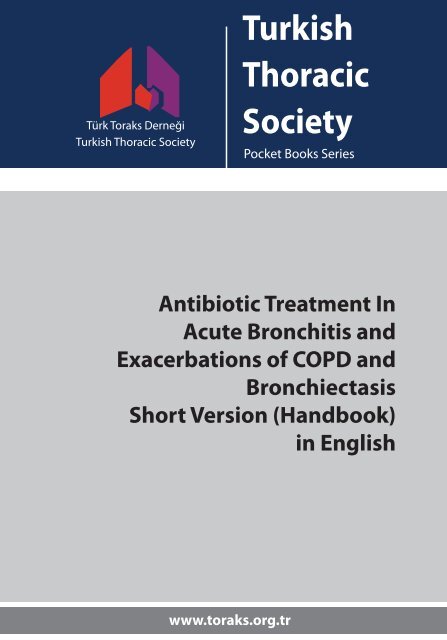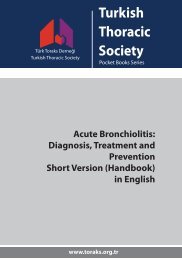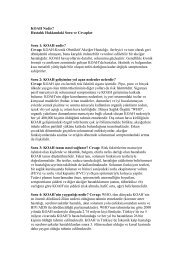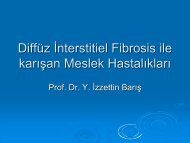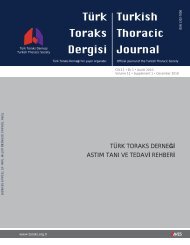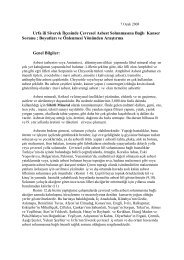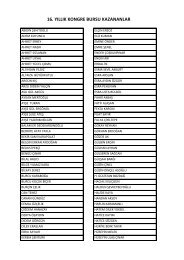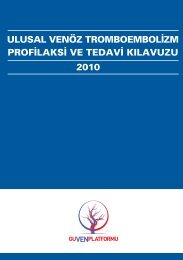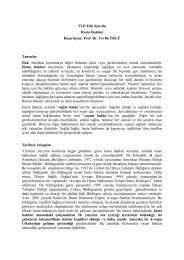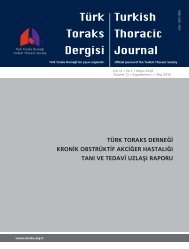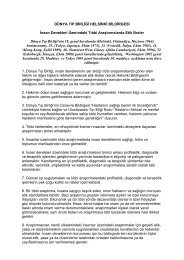Antibiotic Treatment In Acute Bronchitis and Exacerbations of COPD ...
Antibiotic Treatment In Acute Bronchitis and Exacerbations of COPD ...
Antibiotic Treatment In Acute Bronchitis and Exacerbations of COPD ...
Create successful ePaper yourself
Turn your PDF publications into a flip-book with our unique Google optimized e-Paper software.
Türk Toraks Derneği<br />
Turkish Thoracic Society<br />
Turkish<br />
Thoracic<br />
Society<br />
Pocket Books Series<br />
<strong>Antibiotic</strong> <strong>Treatment</strong> <strong>In</strong><br />
<strong>Acute</strong> <strong>Bronchitis</strong> <strong>and</strong><br />
<strong>Exacerbations</strong> <strong>of</strong> <strong>COPD</strong> <strong>and</strong><br />
Bronchiectasis<br />
Short Version (H<strong>and</strong>book)<br />
in English<br />
www.toraks.org.tr
This report was prepared <strong>and</strong> written by<br />
Abdullah Sayıner, Mehmet Polatlı, Lütfü Çöplü<br />
The full text <strong>of</strong> the report is published in Turkish in<br />
Turkish Thoracic Journal 2009;10 (Supplement 3)<br />
Türk Toraks Derneği<br />
Turkish Thoracic Society<br />
Turkish Thoracic Society<br />
Turan Güneş Boulevard, No: 175/19 Oran-Ankara-Turkey<br />
Telephone Number: +90 312 490 40 50<br />
Fax Number: +90 312 490 41 42<br />
E-mail address: toraks@toraks.org.tr<br />
Website: www.toraks.org.tr
<strong>Treatment</strong> approach in acute bronchitis<br />
• Basically symptomatic. A great majority is viral.<br />
<strong>In</strong>dications <strong>of</strong> antibiotic treatment in <strong>COPD</strong><br />
exacerbations<br />
• The presence <strong>of</strong> all three <strong>of</strong> the following symptoms:<br />
increased dyspnea, increase in amount <strong>of</strong> sputum <strong>and</strong><br />
purulent sputum (Anthonisen Type 1)<br />
• The presence <strong>of</strong> two <strong>of</strong> the three cardinal symptoms,<br />
with the condition that one <strong>of</strong> the symptoms is<br />
purulent sputum (Anthonisen Type 2)<br />
Risk factors for P. aeruginosa infection in exacerbations<br />
<strong>of</strong> <strong>COPD</strong> <strong>and</strong> bronchiectasis<br />
• Hospitalization within the last month<br />
• <strong>Antibiotic</strong> use, four times or more in the preceding year<br />
or once within the last month<br />
• Severe exacerbation (associated with respiratory<br />
failure)<br />
• Detection <strong>of</strong> P. aeruginosa in sputum in previous<br />
exacerbation or in stable period<br />
Risk factors for treatment failure or early relapse in<br />
<strong>COPD</strong> exacerbations (criteria for complicated<br />
exacerbation)<br />
• The presence <strong>of</strong> comorbidity (especially heart disease)<br />
• Severe <strong>COPD</strong> (FEV 1<br />
< 50%)<br />
• History <strong>of</strong> four or more exacerbations in the preceding<br />
year<br />
• <strong>Antibiotic</strong> use within the last 3 months<br />
5
Recommendations for antibiotic treatment in infective <strong>COPD</strong> exacerbations<br />
Group<br />
A<br />
B<br />
C<br />
Features <strong>of</strong> exacerbation <strong>and</strong> <strong>of</strong><br />
the patient<br />
Mild <strong>and</strong> simple exacerbation<br />
(No respiratory failure, non- severe<br />
obstruction, no comorbidity, three<br />
or fewer exacerbations in the<br />
preceding year, no antibiotic use<br />
within the last 3 months)<br />
Moderate-severe, complicated<br />
exacerbation<br />
(Risk factors for treatment failure<br />
present – Table 2; no risk factor for<br />
P. aeruginosa – Table 3)<br />
Severe exacerbation with risk <strong>of</strong><br />
Pseudomonas infection<br />
(Table 3)<br />
Possible pathogens First-line oral antibiotics 1 Alternative agents 1 Parenteral treatment<br />
options<br />
H. influenzae<br />
S. pneumoniae<br />
M. catarrhalis<br />
C. pneumoniae 2<br />
Viruses<br />
Group A bacteria<br />
Bacteria producing<br />
beta-lactamase<br />
Enteric Gram (-)<br />
bacteria<br />
(K. pneumoniae, E. coli<br />
etc.)<br />
Group B bacteria<br />
P. aeruginosa<br />
ESBL(+) EGNB<br />
Amoxicillin 3<br />
Beta-lactam + betalactamase<br />
inhibitor<br />
2 nd generation<br />
cephalosporin 4 Macrolide<br />
2 5<br />
Beta-lactam + betalactamase<br />
inhibitor or<br />
2 nd <strong>and</strong> 3 rd generation<br />
cephalosporin 6<br />
Fluoroquinolone effective<br />
against P. aeruginosa 8<br />
(cipr<strong>of</strong>loxacin)<br />
Respiratory<br />
fluoroquinolones<br />
(gemifloxacin,<br />
lev<strong>of</strong>loxacin,<br />
moxifloxacin) 7<br />
Beta-lactam + betalactamase<br />
inhibitor<br />
2 nd <strong>and</strong> 3 rd generation<br />
cephalosporin<br />
Respiratory<br />
fluoroquinolones<br />
Fluoroquinolone effective<br />
against P. aeruginosa<br />
(cipr<strong>of</strong>loxacin) 8<br />
Anti-Pseudomonas betalactam<br />
antibiotics 8<br />
1<br />
No priority in the order.<br />
2<br />
As it is stated within the text, although these have been detected with serological methods in exacerbations, it is not certain whether atypical bacteria are really the causative agents<br />
or not; there is not enough evidence justifying the use <strong>of</strong> antimicrobials covering the atypical bacteria.<br />
3<br />
Amoxicillin should be given if penicillin-sensitive S.pneumoniae or beta lactamase (-) bacteria are identified in sputum culture . The bioavailability <strong>of</strong> ampicillin is lower than that <strong>of</strong><br />
Amoxicillin.<br />
4<br />
The 2 nd generation cephalosporins that are most effective against H. influenzae are cefuroxime axetil <strong>and</strong> cefprozil<br />
5<br />
The most effective macrolides against H. influenzae <strong>and</strong> S. pneumoniae are azithromycin <strong>and</strong> clarithromycin, respectively.<br />
6<br />
3 rd generation non-pseudomonal cephalosporins are ceftriaxone <strong>and</strong> cefotaxime.<br />
7<br />
They are the first-line antibiotics in patients who have used a beta-lactam within the last 3 months or who are allergic to penicillin. These fluoroquinolones can be considered as first<br />
choice by virtue <strong>of</strong> their effectiveness in exacerbations, their high concentrations in lung tissue <strong>and</strong> respiratory tract secretions <strong>and</strong> their achievement <strong>of</strong> good bacterial eradication.<br />
However, it should not be forgotten that any increase in their use may increase the risk <strong>of</strong> resistance development.<br />
8<br />
Sputum cultures are recommended in these patients. The empiric treatment may be modified <strong>and</strong> a regimen with a narrower spectrum may be chosen based on culture <strong>and</strong><br />
susceptibility results,.<br />
6<br />
7
8<br />
<strong>Antibiotic</strong> recommendations in exacerbations <strong>of</strong> bronchiectasis<br />
Oral treatment Parenteral treatment<br />
Beta-lactam + beta-lactamase inhibitor<br />
3. generation non-pseudomonal cephalosporin<br />
Respiratory fluoroquinolone<br />
Beta-lactam +<br />
beta-lactamase<br />
inhibitor<br />
Respiratory<br />
fluoroquinolone<br />
Patients without<br />
any risk factor for<br />
Pseudomonas<br />
Cipr<strong>of</strong>loxacin * Cipr<strong>of</strong>loxacin<br />
3. or 4. generation anti-pseudomonal cephalosporin<br />
Carbapenem<br />
Piperacillin-tazobactam<br />
Anti-pseudomonal beta-lactam +<br />
FQ or aminoglycoside<br />
Patients with<br />
risk factor for<br />
Pseudomonas<br />
* <strong>In</strong> exacerbations <strong>of</strong> patients with bronchiectasis due to IgG insufficiency, an antibiotic effective against gram +bacteria<br />
(e.g. a beta-lactam) should be given together with cipr<strong>of</strong>loxacin with the aim to cover S. pneumoniae<br />
Türk Toraks Derneği<br />
Turkish Thoracic Society


